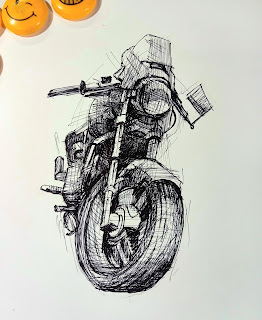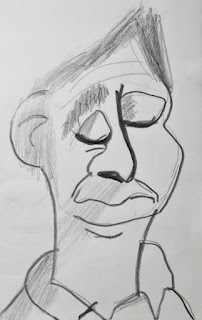O mongol e o gavião - The Mongol and the Falcon
O mongol e o gavião
The Mongol and the Falcon
Gosto de iniciar com um lápis HB, marcando levemente as linhas de construção e contorno. Nesta etapa, não buscamos detalhes — o importante é captar o movimento, a distribuição das formas e a harmonia entre as figuras. O foco está em “ver o todo” antes de mergulhar nas partes.
Quando todos finalizam o esboço e estão satisfeitos com o resultado, passamos à etapa de finalização. Utilizamos uma caneta nanquim 0,4 mm para reforçar os contornos e definir os detalhes — uma fase que exige paciência e precisão.
Com o desenho delineado, damos vida à cena com canetas permanentes de dupla ponta. Elas são ideais para ilustrações expressivas, por sua variedade de tons e pela rapidez com que permitem colorir. Iniciamos pelos tons de cinza nas asas do gavião, aplicando primeiro as cores mais claras e, em seguida, reforçando as sombras e contrastes.
O mesmo processo é seguido nas demais áreas do desenho: começamos pelas zonas iluminadas e depois acrescentamos as tonalidades mais escuras, criando profundidade e equilíbrio visual.
Por fim, acrescentamos pequenos detalhes que fazem toda a diferença — o chão de pedras, as sombras sutis e as montanhas ao fundo, que completam a atmosfera da cena.
The Mongol and the Falcon
I like to start with an HB pencil, lightly outlining the construction lines and contours. At this stage, we don’t focus on details — what matters is capturing the overall movement, the balance of shapes, and the harmony between the figures. The goal is to see the whole before working on the parts.
Once everyone is satisfied with their sketches, we move on to the final stage. Using a 0.4 mm ink pen, we carefully go over the contours to define and refine each detail — a process that requires both patience and precision.
With the linework completed, we bring the illustration to life using dual-tip permanent markers. They are perfect for expressive illustrations because of their range of colors and their agility in application. We start with shades of gray on the falcon’s wings, applying lighter tones first and then deepening the contrast with darker ones.
The same approach is used for the rest of the drawing — beginning with the light areas and gradually layering darker tones to build depth and balance.
Finally, we add small touches that enhance e atmosphere — the rocky ground, subtle shadows, and distant mountains that complete the composition.




Comentários
Postar um comentário